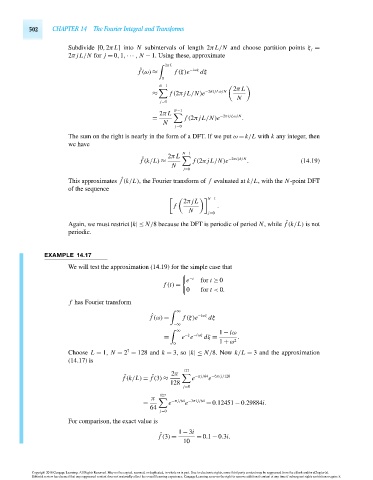Page 522 - Advanced engineering mathematics
P. 522
502 CHAPTER 14 The Fourier Integral and Transforms
Subdivide [0,2π L] into N subintervals of length 2π L/N and choose partition points ξ j =
2π jL/N for j = 0,1,··· , N − 1. Using these, approximate
2π L
ˆ
f (ω) ≈ f (ξ)e −iωξ dξ
0
N−1
−2πij Lω/N 2π L
≈ f (2π jL/N)e
N
j=0
N−1
2π L
= f (2π jL/N)e −2πij Lω/N .
N
j=0
The sum on the right is nearly in the form of a DFT. If we put ω = k/L with k any integer, then
we have
N−1
2π L
ˆ
f (k/L) ≈ f (2π jL/N)e −2πijk/N . (14.19)
N
j=0
This approximates f (k/L), the Fourier transform of f evaluated at k/L, with the N-point DFT
ˆ
of the sequence
N−1
2π jL
f .
N j=0
ˆ
Again, we must restrict |k|≤ N/8 because the DFT is periodic of period N, while f (k/L) is not
periodic.
EXAMPLE 14.17
We will test the approximation (14.19) for the simple case that
e −t for t ≥ 0
f (t) =
0 for t < 0.
f has Fourier transform
∞
ˆ
f (ω) = f (ξ)e −iωξ dξ
−∞
∞ 1 − iω
−ξ −iωξ
= e e dξ = .
0 1 + ω 2
7
Choose L = 1, N = 2 = 128 and k = 3, so |k|≤ N/8. Now k/L = 3 and the approximation
(14.17) is
127
2π
ˆ
e
ˆ
f (k/L) = f (3) ≈ e −π j/64 −6πij/128
128
j=0
127
π
e
= e −π j/64 −3πij/64 = 0.12451 − 0.29884i.
64
j=0
For comparison, the exact value is
1 − 3i
ˆ
f (3) = = 0.1 − 0.3i.
10
Copyright 2010 Cengage Learning. All Rights Reserved. May not be copied, scanned, or duplicated, in whole or in part. Due to electronic rights, some third party content may be suppressed from the eBook and/or eChapter(s).
Editorial review has deemed that any suppressed content does not materially affect the overall learning experience. Cengage Learning reserves the right to remove additional content at any time if subsequent rights restrictions require it.
October 14, 2010 16:43 THM/NEIL Page-502 27410_14_ch14_p465-504

